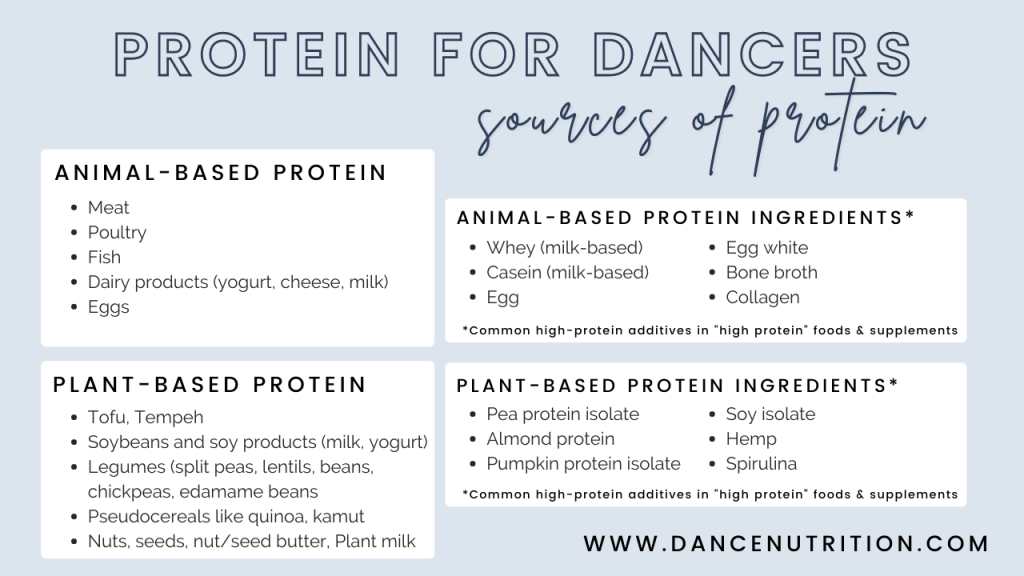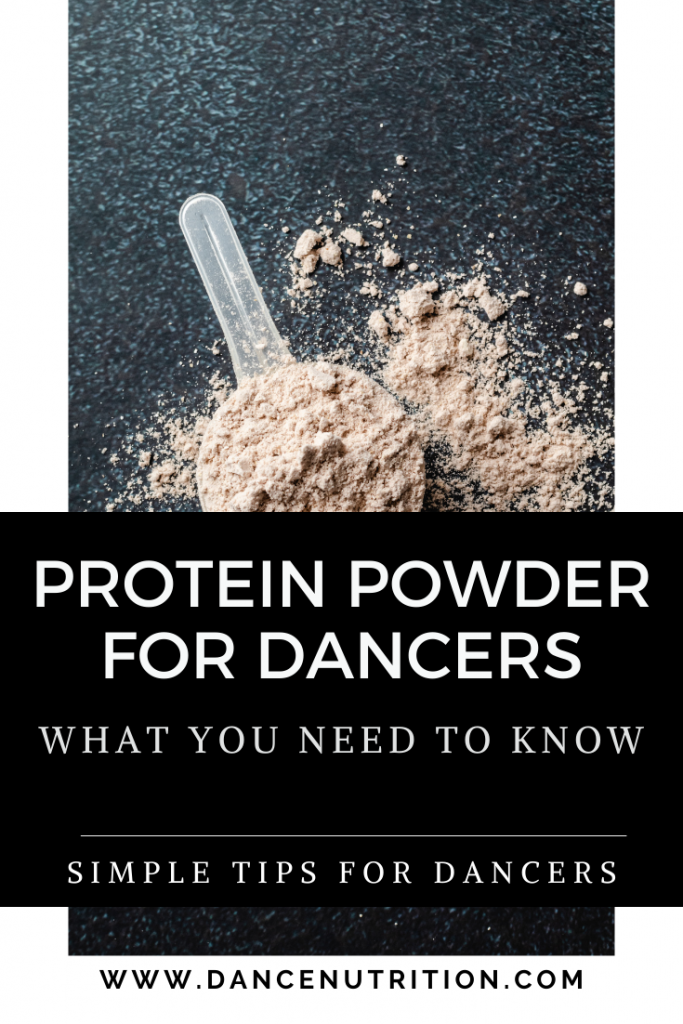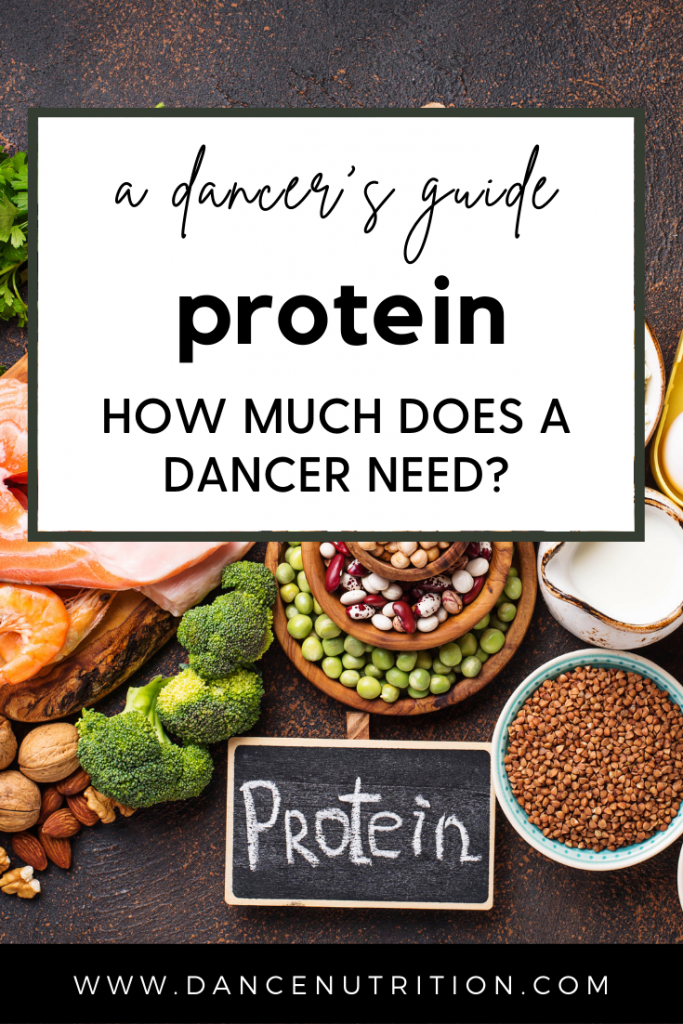Protein is an essential nutrient for dancers, playing a key role in rebuilding and repairing muscle tissue after the repetitive impact of class, rehearsal, and performance. I’ve covered the importance of dietary protein in a dancer’s meal plan here, but many dancers still wonder: Do I need protein powder?
While research supports protein intake after exercise to stimulate muscle protein synthesis, there’s no evidence that powders outperform food or lead to greater training adaptations when compared to whole-food protein sources.
Should Dancers Add Protein Powder to Their Diet?
For most dancers, a food-first approach is ideal. Protein powders are supplements, not replacements for meals, snacks, or consistent eating patterns. They’re also part of an industry with limited regulation and variable safety standards. You can read more about the safety concerns of the supplement industry here.
That said, protein powders can be helpful in specific scenarios:
- When your schedule is so packed that getting enough protein from meals alone is difficult
- When you need quick post-class recovery and don’t have access to food
- When you struggle to meet protein needs during injury recovery
- When appetite is suppressed after high-intensity training and liquids feel easier to tolerate
It’s also worth noting that protein bars fall under this same umbrella: convenient at times, but not meant to replace the foundation of a dancer’s fueling plan.
When combined with training, protein supplements can support strength gains. But it’s important to note that these benefits are also seen with the inclusion of high-protein foods into one’s diet. And last, some question whether or not extra protein helps to maintain muscle mass when you’re not able to dance (like if you’re recovering from an injury), but the research is mixed.
Bottom line: protein powder is optional, not essential. It’s a tool, not a requirement.
How Much Protein Powder Is Too Much?
A persistent myth claims the body can only absorb 20 grams of protein in one sitting. In reality, the body absorbs what it needs based on age, activity level, and metabolic demands— typically around 30 grams per meal for active individuals.
For dancers, the key is evenly distributing protein throughout the day, aiming for:
- ~20–30 grams of protein at meals
- 10–20 grams at supportive snacks
- For athletes, a protein source within an hour after intense training (food or supplement) to optimize muscle recovery
More protein is not better. Excess reliance on supplements can crowd out carbohydrates (your body’s preferred fuel), contribute to dehydration, and trigger digestive symptoms, especially if powders contain artificial sweeteners or sugar alcohols. Also, keep in mind that much of the research in this area is performed either on older adults or athletes, not dancers. While not ALL of the protein in your meal will be utilized for muscle building, some can be used for other purposes like building hormones, enzymes, and antibodies.
Protein Supplements: What to Consider
Protein powders vary widely in taste, texture, digestibility, and ingredient quality. Before choosing one, consider two main questions:
1. Do you prefer plant-based or animal-based protein?
2. What additives are included?
Many powders contain stevia, monk fruit, sugar alcohols (erythritol, xylitol, maltitol), and synthetic fibers (inulin, chicory root). These ingredients can cause stomach upset and discomfort for some dancers, so you’ll want to either opt out of these options or trial small quantities (such as half a serving) at a time.
Below are the most common types, with clear pros and cons for dancers.
Plant-Based Protein Options:
Pea Protein
- Complete protein, rich in branch chain amino acids (BCAAs)
- It can be slightly less bioavailable or usable when compared to others
- Great option when part of an overall balanced day
Soy Protein
- Complete protein with strong research behind it
- Comparable to whey in stimulating muscle recovery
- In regard to hormones, research suggests that those with a predisposition to thyroid dysfunction should limit their consumption of soy-based protein.
Rice Protein
- Has been compared to whey protein, with both resulting in improvements in muscle strength and performance.
- Easily digestible
- Not a complete protein— best in blended plant-based powders
Hemp Protein
Hemp protein does not have the same psychoactive properties as marijuana. One of the main proteins in hemp is albumen, the same protein found in egg whites. Here’s what we know:
- Contains all essential amino acids
- Limited research on performance benefits
- Often has a gritty texture
Peanut & Almond Protein
- Helpful additions if no allergies
- Missing one essential amino acid, but this is rarely a practical concern since it’s abundant elsewhere in the average human diet
- Works well as part of a mixed protein intake
Animal-Based Protein Options
Whey Protein
- The gold standard for muscle recovery, and the most common protein supplement on the market.
- Contains the highest percentage of branched-chain amino acids (BCAAs)
- Complete protein with a high leucine content. Leucine is an amino acid that stimulates muscle protein synthesis.
- Fast-digesting and well-researched
- Best option for dancers who include dairy and want efficient post-training support
- Milk-based
Casein
- Slower digesting than whey
- Sometimes useful before long rehearsal days or evening recovery
- Can feel heavy for dancers prone to reflux
- Milk-based
Egg or Egg White Protein
- Excellent amino acid profile
- Neutral taste
- A good option for dancers who avoid dairy
Collagen
Collagen is the most abundant protein in the body, forming the structural framework of our skin, hair, tendons, cartilage, bones, and connective tissues. Natural collagen production declines with age—hence the fine lines and sagging that appear over time—which is why collagen supplements are often marketed as an “anti-aging” solution. Bone broth is one of the more popular dietary sources.
When it comes to the research, however, the findings are mixed. A few small studies link collagen supplementation with improvements in skin hydration or elasticity, but these trials are typically short, limited in scope, and often funded by the very companies selling the products. The marketing that surrounds collagen is especially noteworthy because it tends to highlight concerns that dancers also experience when under-fueled: brittle hair and nails, joint discomfort, and compromised bone health. Unfortunately, evidence supporting collagen as a meaningful solution for these issues remains limited at best.
It’s also important to note that collagen is not a complete protein. Unlike whey or soy, it doesn’t provide all of the essential amino acids needed for muscle repair or overall recovery— an important consideration for dancers with high training demands. Fortunately, you don’t need costly powders to support your body’s natural collagen production. Nutrients like vitamin C, zinc, and copper act as cofactors in collagen synthesis and are easily obtained through a varied, well-fueled eating pattern. Protecting your collagen by minimizing behaviors that break it down (ie, smoking or excessive sun exposure) also matters.
If your primary concerns include bone health, injury prevention, or chronic joint pain, the most effective first step is a comprehensive evaluation by a qualified healthcare provider. And more often than not, especially in dancers, addressing under-fueling is part of the solution long before collagen supplements enter the picture. So what should dancers remember?
- Collagen is not a complete protein.
- Evidence for supplementation is inconsistent and often industry-funded.
- You can support natural collagen production with nutrient-rich foods (vitamin C, zinc, copper) and supportive lifestyle habits.
- Collagen isn’t harmful, but it shouldn’t replace high-quality protein sources, especially for dancers with recovery and performance needs.

Which Protein Powder Is Best for Dancers?
For dancers who eat animal products, whey protein is the most effective, researched, and predictable option. For plant-based dancers, choose a plant-blend powder (pea + rice, soy + brown rice) to ensure all essential amino acids. Or, be sure that your protein supplementation (like pea, almond, or peanut) is not your ONLY source of protein for the day. You can utilize this to increase the protein content of your smoothie by adding a protein powder that contains at least 20 grams per serving, but it’s just a fraction of your overall daily food intake. limit intake to one serving per day or a few times per week.
Protein Powder for Dancers: Key Takeaways
Protein supplements (powders and bars) are convenient tools that can support recovery when used strategically. Though sometimes helpful (especially in circumstances like this), they should never replace real food, balanced meals, or consistent eating— these are the foundations of a dancer’s performance, strength, and longevity.
Aiming for varied, food-first protein sources throughout the day (beans, lentils, poultry, eggs, yogurt, nuts, fish) will meet most dancers’ needs without relying heavily on expensive supplements. If you choose to use a supplement, consider this:
- Choose third-party tested brands
- Avoid powders with sweetened with stomach disruptors like sugar alcohols and sugar-free alternatives
- Aim for 20 grams or less per serving (similar to protein bar recommendations)
Comparison Chart: Protein Powders for Dancers
| Type of Protein | Rank | Best For | Pros | Cons | Notes |
| Whey Protein | #1 Best Overall | Dancers who consume dairy | Complete protein; high leucine; fast absorption; top research support | Not suitable for dairy-free dancers; may cause bloating for some | Most effective for post-class recovery and strength support |
| Plant-Based Blends (Pea + Rice / Soy + Rice) | #2 Best Plant-Based | Plant-based dancers or dairy-free dancers | Complete amino acid profile; easy to digest; widely available | Some blends contain sweeteners/sugar alcohols | Choose blends to ensure completeness |
| Soy Protein | #3 Strong Single-Source Plant Protein | Dancers okay with soy intake | Complete protein; similar efficacy to whey | Not tolerated by everyone; mixed data for thyroid concerns | Reliable option |
| Egg / Egg White Protein | #4 Good Dairy-Free Animal Protein | Dairy-free dancers | High-quality complete protein; neutral taste | Less common; pricier | Great for recovery |
| Pea Protein | #5 Solid Option if Part of a Varied Diet | Plant-based dancers | Good BCAA profile; digestible | Slightly lower bioavailability; not as complete as blends | Works well when overall daily protein is diverse |
| Brown Rice Protein | #6 Easy to Digest | Dancers with sensitive digestion | Gentle on stomach | Not a complete protein | Best in blends, not ideal as a primary protein source |
| Hemp Protein | #7 Nutrient-Dense but Limited Research | Dancers wanting a whole-food powder | Contains essential amino acids; fiber-rich | Gritty texture; limited performance research | Fine to use occasionally, but not best for muscle repair |
| Collagen | Not a Complete Protein | Dancers wanting skin/joint support | Supports connective tissue; trendy | Not complete; weak performance evidence | Not suitable as a primary protein source for dancers; neutral add-in at best |





